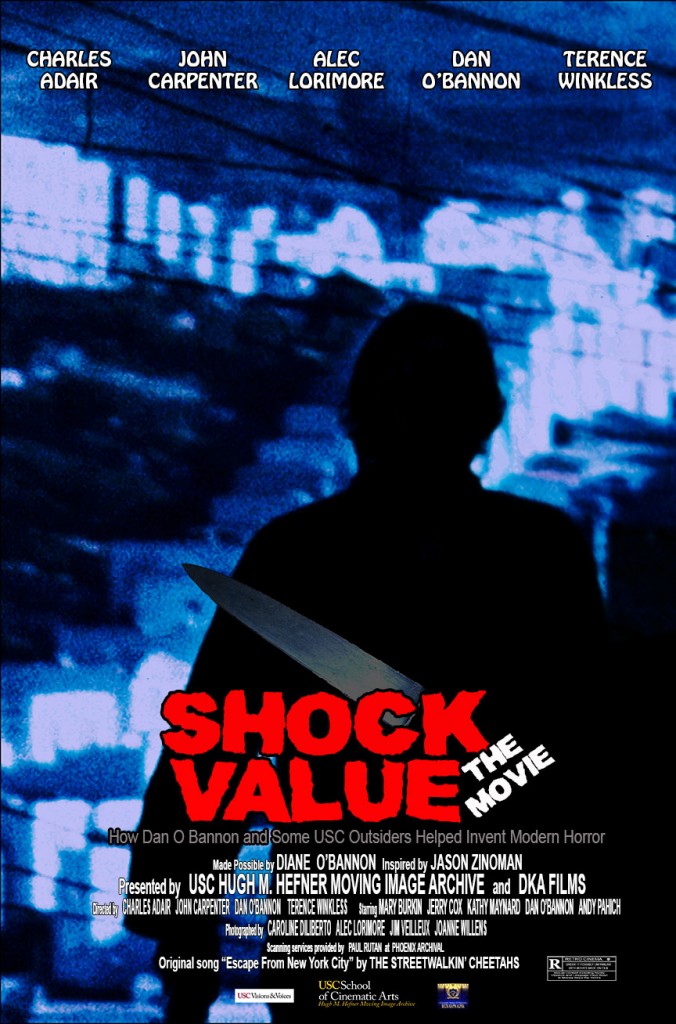Shock Value: The Movie—How Dan O’Bannon and Some USC Outsiders Helped Invent Modern Horror
In a fascinating feature-length horror anthology, Shock Value: The Movie—How Dan O’Bannon and Some USC Outsiders Helped Invent Modern Horror, archivist Dino Everett proves that USC students O’Bannon, John Carpenter and others began redefining the horror genre while at the School of Cinematic Arts in the 1970s.
Using New York Times writer Jason Zinoman’s book Shock Value as inspiration, USC Hugh M. Hefner Moving Image Archive archivist Dino Everett assembled a feature-length compilation of SCA student works from the late ’60s and ’70s entitled Shock Value: The Movie—How Dan O’Bannon and Some USC Outsiders Helped Invent Modern Horror. The compilation features recently uncovered and previously unseen student films by O’Bannon (Alien, Total Recall) and John Carpenter (Halloween, Escape from New York)—including their very first pairing in 1968, Good Morning Dan! Along with Carpenter’s Captain Voyeur and 2 versions of O’Bannon’s Blood Bath, a film which cemented Carpenter’s desire to work with O’Bannon outside of film school(see Carpenter interview in 1980 issue of Cinemafantastique -Vol 10 no. 1 pg 9-). In addition, films by their classmates Terry Winkless (Mighty Morphin Power Rangers, The Nest), Alec Lorimore (an Oscar-nominated documentary producer) and Charles Adair’s (Bleeders) zombie film The Demon, to show how USC was a major birthplace for the redefining of the horror genre in the 1970s.
The crown jewel of the program is a short by Winkless and Lorimore and starring O’Bannon entitled Judson’s Release. Made in 1971, Judson’s Release is the blueprint for films such as Halloween, Black Christmas, He Knows You’re Alone and countless others, and O’Bannon’s relentless and emotionless portrayal of the killer resembles Jason, Michael Myers and many other film killers who would follow.
Everett likens it to watching Keith Richards learn how to play guitar, “There are moments of brilliance coupled with moments that remind us these legends were still learning. Even in a dark comedy like Captain Voyeur you can see shots resembling the horror to be found in his later films”
Shock Value: The Movie premiered at USC on October 17th, and since has been available for single event Festival and Repertory screenings thereafter, in order to raise the funds needed to properly restore these films for the long term.
For booking information of this DCP, please contact Dino Everett deverett@cinema.usc.edu
THE FILMS
Blood Bath (1969, 1976 written and directed by Dan O’Bannon) B/W (original 16mm) 7 min
A slovenly young man commits suicide out of curiosity and boredom. O’Bannon revisited this short after the aborted DUNE project and while working on Star Wars, making it slightly longer and giving it a blood red tint.
The Demon (1970, written and directed by Charles Adair) B/W (original 16mm) 19 min
A woman left alone in a desert home begins to feel she is being watched.
Good Morning Dan (1968, written and directed by Dan O’Bannon camera by John Carpenter) Color (original 8mm) 19 min
Set in what was then the distant future of 2006, an old man reminisces on his days back at USC
Captain Voyeur (1969, written and directed by John Carpenter) B/W (original 16mm) 7 min
A dull office worker transforms into a costumed peeping tom at night
Judson’s Release (aka Foster’s Release 1971, written by Alec Lorimore, Directed by Terence Winkless) (original 16mm) Color 15min
A young man returns to a small town and begins to torment a girl who is babysitting a little boy.
Total program time 75 min
BACKGROUND OF PROJECT
It all began when I took over the archive in 2010 and set a goal to find John Carpenter’s student films, because I grew up on horror and knew that he had attended USC back in the day. My motivation was that most of the writing has only ever mentioned The Resurrection of Broncho Billy which won an Oscar in 1971, but is not really a “John Carpenter” film since he was not the writer and director. Within the first year I found Carpenter’s 310 entitled Captain Voyeur and was able to restore it through a grant from the National Film Preservation Foundation (NFPF). I then set off to find other important horror-related USC students films such as those by Dan O’Bannon, but kept coming up empty. I knew the name of one of O’Bannon’s films, Blood Bath, but I was unable to locate any material and so my quest went into hibernation.
A year or so later I picked up a new book by NY Times writer Jason Zinoman, entitled SHOCK VALUE : How a Few Eccentric Outsiders Gave Us Nightmares, Conquered Hollywood and Invented Modern Horror. Upon reading the book I realized that he had some specific details about Blood Bath and so I reached out to him, and he told me that he saw a version of the film that was loaned to him from Dan’s widow, Diane O’Bannon and he put me in touch with her. It took a while to actually connect face to face with Diane who had been dealing with the death of her husband and the large amount of material he had left behind, not to mention finishing the release of a book on screenwriting that Dan had finished entitled Dan O’Bannon’s Guide to Screenplay Structure. Once I did she pulled out of storage a number of boxes that contained not only the elements to Blood Bath, but all of O’Bannon’s original 290’s, and a film he starred in Foster’s Release. When I saw the material I jumped like a little kid, and immediately brought it to USC to investigate. What I found was spectacular material, with Foster’s Release being simply one of the most important films I have ever seen, because it turned out to be the blueprint for many of the classic films in Zinoman’s book, most notably Halloween.
My next plan was to reach out to the makers of Foster’s Release and find out more details. The first thing I found out was that the film was really called Judson’s Release and only took on the “Foster’s” moniker when they got a small distribution deal with the educational film company Pyramid in the early 1970’s. The film’s director Terence Winkless stated that the company had already finished printing their new catalog, and the only way for their film to appear was if it started with the letter “F”, because that was the only section left with some space. They changed the name and the film did its small run as a scare tactic babysitting awareness film and then disappeared for 40 years while Winkless, and the film’s screenwriter Alec Lorimore went on to have mostly non-horror careers in Hollywood. Carpenter’s Halloween came out in 1978 and he went on to legendary status, while O’Bannon had a successful career in Hollywood, but never quite reached the success of Carpenter.
From the research I did compiling this project I soon learned that O’Bannon was this unsung hero, not only of modern horror, but also for his time here at USC. His work here in the 1960’s was really quite advanced and ahead of its time compared to many of his classmates, and he seemed to not only be a jack of all trades, such as writer, director, actor, makeup and effects, but also seemed to be a one man creativity catalyst contributing often to his fellow classmates’ projects
The other thing I learned through all of this was that he was a fiercely loyal individual and showed a caring side that many might not suspect. In the 1990’s an old classmate of Carpenter and O’Bannon’s named Charles Adair (who made the zombie film The Demon, included in this project) was in failing health and in need of funds for his medical bills. O’Bannon co-wrote a script with Adair for a horror project called Bleeders (1997) and gave Adair all of the profits made from the writing job to help with the bills.
PRESERVATION OF THE FILMS
At this point the only project which has been properly and completely preserved would be the Carpenter film Captain Voyeur, thanks to the funds granted from the NFPF. The remaining films have only been scanned in at 2K for this project with the hopes that funds acquired from the screenings will help pay for proper photochemical preservation of the remaining shorts.
At present no prints exist for Blood Bath, only the negative A & B rolls and extra elements for the 1976 versions. The Demon has one print and the negative elements, and Judson’s Release and Good Morning Dan (the only 8mm print) only exist as a single answer print, but no negatives. There was one project that I wanted to include very desperately which was John Carpenter’s 480 thesis film Lady Madonna, but as yet only the sound element has been located.
PRESS
So far a 3 issue expose appeared in the largest fantasy film magazine in Spain entitled SCI-FI-WORLD and an interview in the U.S. equivalent FANGORIA. Write ups have appeared in the Hollywood Reporter, New York Times as well as a radio piece done for NPR.
1-213-740-2921 Dino Everett deverett@cinema.usc.edu

